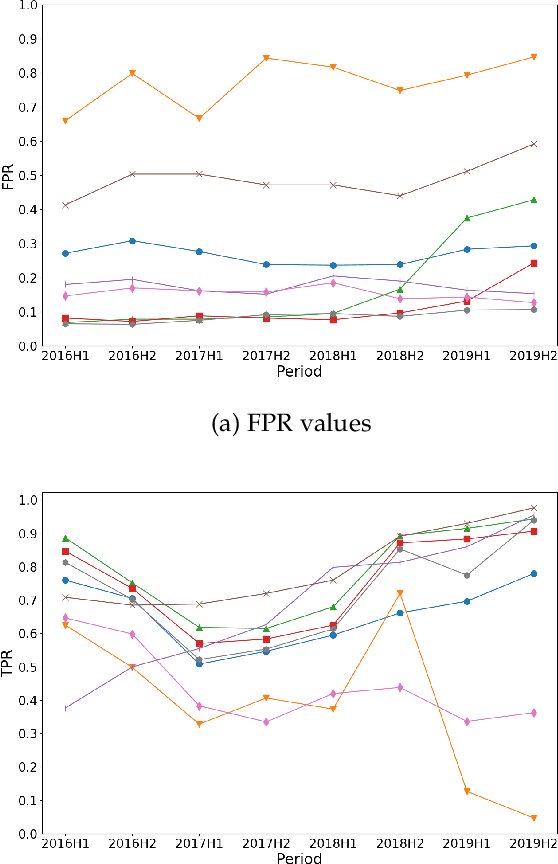Borja Molina-Coronado
Celtibero: Robust Layered Aggregation for Federated Learning
Aug 26, 2024Abstract:Federated Learning (FL) is an innovative approach to distributed machine learning. While FL offers significant privacy advantages, it also faces security challenges, particularly from poisoning attacks where adversaries deliberately manipulate local model updates to degrade model performance or introduce hidden backdoors. Existing defenses against these attacks have been shown to be effective when the data on the nodes is identically and independently distributed (i.i.d.), but they often fail under less restrictive, non-i.i.d data conditions. To overcome these limitations, we introduce Celtibero, a novel defense mechanism that integrates layered aggregation to enhance robustness against adversarial manipulation. Through extensive experiments on the MNIST and IMDB datasets, we demonstrate that Celtibero consistently achieves high main task accuracy (MTA) while maintaining minimal attack success rates (ASR) across a range of untargeted and targeted poisoning attacks. Our results highlight the superiority of Celtibero over existing defenses such as FL-Defender, LFighter, and FLAME, establishing it as a highly effective solution for securing federated learning systems against sophisticated poisoning attacks.
Light up that Droid! On the Effectiveness of Static Analysis Features against App Obfuscation for Android Malware Detection
Oct 24, 2023



Abstract:Malware authors have seen obfuscation as the mean to bypass malware detectors based on static analysis features. For Android, several studies have confirmed that many anti-malware products are easily evaded with simple program transformations. As opposed to these works, ML detection proposals for Android leveraging static analysis features have also been proposed as obfuscation-resilient. Therefore, it needs to be determined to what extent the use of a specific obfuscation strategy or tool poses a risk for the validity of ML malware detectors for Android based on static analysis features. To shed some light in this regard, in this article we assess the impact of specific obfuscation techniques on common features extracted using static analysis and determine whether the changes are significant enough to undermine the effectiveness of ML malware detectors that rely on these features. The experimental results suggest that obfuscation techniques affect all static analysis features to varying degrees across different tools. However, certain features retain their validity for ML malware detection even in the presence of obfuscation. Based on these findings, we propose a ML malware detector for Android that is robust against obfuscation and outperforms current state-of-the-art detectors.
Towards a Fair Comparison and Realistic Design and Evaluation Framework of Android Malware Detectors
May 25, 2022



Abstract:As in other cybersecurity areas, machine learning (ML) techniques have emerged as a promising solution to detect Android malware. In this sense, many proposals employing a variety of algorithms and feature sets have been presented to date, often reporting impresive detection performances. However, the lack of reproducibility and the absence of a standard evaluation framework make these proposals difficult to compare. In this paper, we perform an analysis of 10 influential research works on Android malware detection using a common evaluation framework. We have identified five factors that, if not taken into account when creating datasets and designing detectors, significantly affect the trained ML models and their performances. In particular, we analyze the effect of (1) the presence of duplicated samples, (2) label (goodware/greyware/malware) attribution, (3) class imbalance, (4) the presence of apps that use evasion techniques and, (5) the evolution of apps. Based on this extensive experimentation, we conclude that the studied ML-based detectors have been evaluated optimistically, which justifies the good published results. Our findings also highlight that it is imperative to generate realistic datasets, taking into account the factors mentioned above, to enable the design and evaluation of better solutions for Android malware detection.
Survey of Network Intrusion Detection Methods from the Perspective of the Knowledge Discovery in Databases Process
Jan 27, 2020



Abstract:The identification of cyberattacks which target information and communication systems has been a focus of the research community for years. Network intrusion detection is a complex problem which presents a diverse number of challenges. Many attacks currently remain undetected, while newer ones emerge due to the proliferation of connected devices and the evolution of communication technology. In this survey, we review the methods that have been applied to network data with the purpose of developing an intrusion detector, but contrary to previous reviews in the area, we analyze them from the perspective of the Knowledge Discovery in Databases (KDD) process. As such, we discuss the techniques used for the capture, preparation and transformation of the data, as well as, the data mining and evaluation methods. In addition, we also present the characteristics and motivations behind the use of each of these techniques and propose more adequate and up-to-date taxonomies and definitions for intrusion detectors based on the terminology used in the area of data mining and KDD. Special importance is given to the evaluation procedures followed to assess the different detectors, discussing their applicability in current real networks. Finally, as a result of this literature review, we investigate some open issues which will need to be considered for further research in the area of network security.
 Add to Chrome
Add to Chrome Add to Firefox
Add to Firefox Add to Edge
Add to Edge